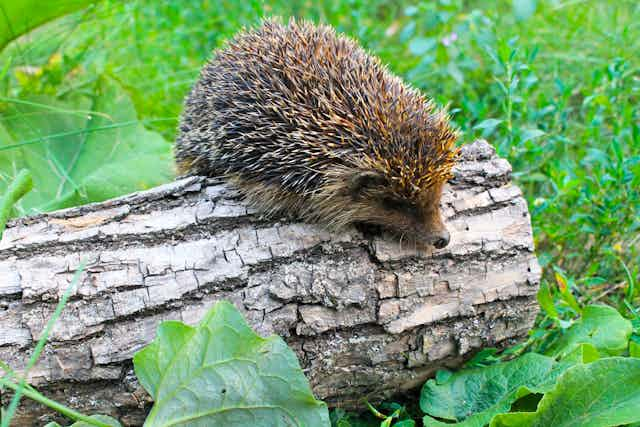Britain’s urban hedgehog populations are stabilising after decades of worrying decline, although numbers in the countryside are still falling, a new report has found.
Gaps under boundary fences, known as “hedgehog highways”, are being heralded as a key driver in this improvement for hedgehogs in cities and towns.
A hole at the base of a boundary fence will create a valuable, connected network of green space that hedgehogs can roam through. Whether it is a drilled hole in a wall or natural gap in an old wooden fence, highways help hedgehogs in their quest to find enough food and mates.
Hedgehogs disappeared
Urban and suburban areas have become busier and more dangerous for wildlife. Connected green space, such as these highways, increase hedgehog habitats and provide key refuges from pressures in the wider landscape, such as traffic.
Listed as vulnerable to extinction in Britain’s red list for mammals, hedgehogs have been subject to significant conservation efforts. Key players in the fight for hedgehog survival – People’s Trust for Endangered Species and The British Hedgehog Preservation Society – published a report on the state of Britain’s hedgehogs this year. They also run a campaign called Hedgehog Street focusing on local action and encouraging people to create hedgehog highways in their gardens.
Hedgehog numbers have shown a 30%-75% decline across different areas of the countryside since 2000. Why hedgehogs are disappearing isn’t straightforward.
Agricultural intensification has led to the loss of habitats. Great Britain has lost an estimated 50% of their hedgerows since World War II. Pesticide use and slug pellets kill the slugs, worms, beetles and other invertebrates that hedgehogs rely on.
Urban areas are also being built with impenetrable fences that can fragment populations of ground-dwelling animals such as hedgehogs. If that wasn’t enough, hedgehogs face a greater risk from vehicles than ever before due to an increasing road network.

All is not lost, however. A report by Gloucestershire Wildlife Trust set out to monitor the animals’ presence before and after making holes in people’s garden fences. There were several encouraging results, including a 39% increase in hedgehog sightings after people made highways.
In a similar study in Reading, researchers reported that 54% of people observed an increase in hedgehog activity in their gardens after creating at least one hedgehog highway. The gardens changed from being isolated oases to part of a larger haven for hedgehogs.
Read more: Five ways to use your garden to support your wellbeing
There are approximately 520 thousand hectares of residential garden space in urban areas in Great Britain. That’s 29.5% of the total urban area. Undoubtedly, gardens are a critical place to ensure co-existence with wildlife.
Neighbourhood highways
Despite being relatively small animals, hedgehogs can travel up to 2km and visit up to 13 gardens per night through well-connected habitats. So while there are benefits to connecting two or three gardens, it’s not enough. Green spaces need to be joined up across neighbourhoods to allow hedgehogs to access the varied resources they need to survive.
Hedgehog highways can also generate community spirit. The village of Kirtlington, Oxfordshire, is proud of its hedgehog highway where there are 60 connected houses, with gaps, holes and even ramps in all shapes and sizes for hedgehogs to use. Other villages have announced plans to create similar networks in their bid to create the country’s longest hedgehog highway.
It is estimated that more than 120,000 highways connecting around 240,000 gardens have been created in the UK. This is equivalent to approximately 1.1% of UK households with access to a garden. Although incredibly valuable, there is still a long way to go to protect these prickly creatures.
How to create a highway
Removing barriers to a hedgehog’s nightly wandering is the most important action we can take for the species. A 13cm x 13cm hole is sufficient to create a corridor from one garden to the next. This can be drilled through wooden fence panels or be a gap cut in a wire fence. A channel can be dug underneath a fence or gate, or a brick can be removed from a wall.
There’s no maximum number of holes you can create. A hole on more than one boundary will contribute to a bigger habitat network. Those with more ambitious goals may even want to replace the fence with a hedgerow to provide a corridor, nesting spot and food for hedgehogs.
In 2020/2021, house building in England soared to a 33-year high. The development of new homes shows no signs of respite and it is widely considered that building fences with no gaps has contributed to the hedgehog decline.
Developers have a key role to play in preventing the creation of hostile landscapes for nature.
Bovis Homes, Barratt Homes, Taylor Wimpey and several other developers have pledged to include gaps in garden boundaries throughout their housing projects. What’s more, guidance on building hedgehog highways has been added to the National Planning Policy framework.
Hedgehogs have had a bumpy ride, characterised by catastrophic declines over recent decades. Against all odds, however, hedgehog highways provide a glimmer of hope.

